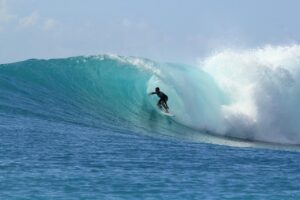When it comes to contemporary surfboards, the terms “fiberglass” or “epoxy” are frequently used incorrectly. When it comes to surfboard materials, the distinctions are much more complicated, and they’re usually a mix of both.
Surfboards are most often constructed of polyurethane or polystyrene foam. The foam is then covered in fiberglass and a waterproof resin before being wrapped in fiberglass.
The material of the foam will differ depending on whether it is handcrafted or machine-formed, and the desired board features.
Types of Resins
The two most popular surfboard resins are epoxy and polyester. The coating or skin over the foam is made of either of these materials.
Epoxy
Beginners will love epoxy-resin coated boards, which are lighter than polyester and easier to paddle. They are also lighter than polyester, making them more convenient to transport and paddle. They float extremely well and provide a buoyancy that new surfers can take advantage of while learning how to catch waves.
A bigger board makes it easier to float and gives more control. A surfboard’s buoyancy can also aid a surfer in maintaining speed and direction as he or she rides the waves. Epoxy decks are also less prone to ding than fiberglass boards; this may be helpful for those who expect to take a few spills.
Epoxy surfboards are popular among highly trained surfers for the same reasons. They’re ideal for boosting performance on small waves, allowing you to perform aerial stunts, and providing a lot of power.
Polyester
A fiberglass cloth and a polyester resin skin are used to make epoxy boards. Surfers enjoy the look and feel of a hand-shaped, polyester board in the water, and their slight increase in weight is frequently seen as a benefit.
When surfing in rough seas, the extra weight will assist to keep the board steady through bumps on the wave’s face. It will also allow for tight turns on huge waves in order to lock into the steep sections.
A little extra weight can aid in the maintenance of speed and power during a barrel ride. In medium to large waves, a polyester board is preferable for experienced surfers wanting to take advantage of these features.
Types of Foam
Surfer’s boards are built out of numerous materials beneath the glossy resin sheath.
Polyurethane (PU) Foam
In the 1950s, polyurethane foam was used for surfboard shaping for the first time and has since revolutionized board design. Shapers can carve polyurethane blanks incredibly finely, resulting in accurate rails, rockers, and dimensions for surfboards today.
SUP boards are very adaptable in the water. This adaptability will allow the surfer to cut into big wave surfing moves. It also allows for a great deal of control over the board’s performance, as it absorbs the power of these waves with excellent hold and speed.
Strings are also found on fiberglass boards. They’re made of polyester, too, with a stringer running down the center. This stringer increases the board’s strength by providing a focal point for the waves and your weight to rebound off of while maintaining flexibility.
Polyurethane’s popularity has been on the decline for over 50 years, since it was discovered that molding with this material produced a variety of health problems, both to the planet and to the shaper.
In 2005, the world’s top provider of PU foam (who had produced over 90% of the world’s PU) abruptly closed its doors. It was time for shapers and producers to look for alternatives.
Shapers in countries where polystyrene is still used (such as the Philippines, India, and China) generally employ this foam and shaping method. If you’re getting a hand-crafted board made by a local shaper, there’s a good chance it’ll be done this way. Polyurethane has largely been replaced by polystyrene.
Polystyrene (PS) Foam
Polystyrene cores are a more environmentally friendly alternative to PU. They are also lighter and less resource-intensive to produce. The production of polystyrene boards is achieved by utilizing a hot wire technique, which entails employing a wire to chop the board into its shape.
Shaping this way reduces airborne pollutants. A machine rather than a shaper is used to perform this operation.
Polystyrene is frequently joined with epoxy resin. As a result, many people call PS boards ‘epoxy boards.’
Expanded Polystyrene (EPS) Foam
Following the installation of Polystyrene panels is expanded polystyrene core materials. EPS is simply another term for styrofoam, which is the same thing used in grocery store coolers!
Small foam balls are compressed to make the core. Because EPS is already quite fragile (before being covered in resin) it is formed by a machine.
Most beginning surfboards are built with EPS foam, which is one of the lightest and most buoyant materials available.
The epoxy resin, like traditional polystyrene, will strengthen the board to prevent it from dinging or fading in the sun.
The machine-made nature of these boards makes them more cost-effective and environmentally friendly than any other board shaping technique. EPS boards are long-lasting, buoyant, and inexpensive to produce.
Wood Surfboards
Shapers enjoy returning to the oldest art of surfboard shaping with wood. Wooden surfboards are still manufactured on occasion. Wood boards will provide a link to surfing’s roots, which is not common in any other form of shaping.
If you ever get the chance to surf a wooden surfboard, prepare for a soothing and spiritual surfing experience, but don’t expect much in terms of performance!
The Future of Surfboards
The future of surfboard shaping, on the other side of things, looks bright. Carbon fiber surfboards are becoming increasingly popular. This offers more flexibility and longevity in the history of surfboard construction materials.
Extruded polystyrene foam, a completely water-resistant foam that doesn’t absorb even if the board is dinged, is available. It’s extremely responsive, flexible, and nimble.
The shapes and science of surfboards are always changing, so use this information to assist you in making decisions for both now and in the future as these boards get made on a larger scale.

